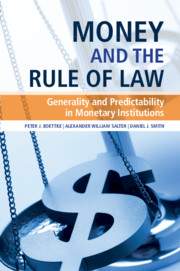Book contents
- Money and the Rule of Law
- Money and the Rule of Law
- Copyright page
- Dedication
- Contents
- Preface
- Acknowledgments
- 1 Introduction
- 2 Knowledge Problems with Discretionary Monetary Policy
- 3 Incentive Problems with Discretionary Central Banking
- 4 When Firefighters Are Arsonists
- 5 On the Shoulders of Giants
- 6 Money and the Rule of Law
- 7 Conclusion
- Index
- References
1 - Introduction
Published online by Cambridge University Press: 13 May 2021
- Money and the Rule of Law
- Money and the Rule of Law
- Copyright page
- Dedication
- Contents
- Preface
- Acknowledgments
- 1 Introduction
- 2 Knowledge Problems with Discretionary Monetary Policy
- 3 Incentive Problems with Discretionary Central Banking
- 4 When Firefighters Are Arsonists
- 5 On the Shoulders of Giants
- 6 Money and the Rule of Law
- 7 Conclusion
- Index
- References
Summary
We provide an overview of the monetary policy failures that resulted in the 2007–2008 financial crisis and ensuing Great Recession, focusing on the United States. Before the crisis, monetary policy was too loose, which fueled the bubble. After the bubble burst, monetary policy became too tight, hindering the recovery. These failures are fundamentally due to the Federal Reserve’s discretionary monetary policy. Furthermore, the popular approach of “constrained discretion” is really just discretion. Hence, it is sensitive to all the usual problems with discretionary monetary policy. Only firm monetary rules, ones that actually bind, can maintain macroeconomic stability and prevent crises.
Keywords
- Type
- Chapter
- Information
- Money and the Rule of LawGenerality and Predictability in Monetary Institutions, pp. 1 - 21Publisher: Cambridge University PressPrint publication year: 2021



